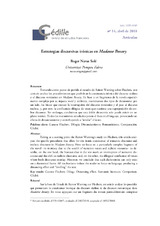Mostrar el registro sencillo del ítem
Estrategias discursivas irónicas en Madame Bovary
| dc.contributor.author | Navas Solé, Roger | |
| dc.date.accessioned | 2019-03-29T09:04:53Z | |
| dc.date.available | 2019-03-29T09:04:53Z | |
| dc.date.issued | 2018 | |
| dc.identifier.issn | 1699-4949 | |
| dc.identifier.uri | http://hdl.handle.net/10396/18329 | |
| dc.description.abstract | Tomando como punto de partida el estudio de Rainer Warning sobre Flaubert, este artículo analiza los procedimientos que posibilitan la coexistencia irónica del discurso realista y el discurso romántico en Madame Bovary. En base a un fragmento de la novela especialmente complejo por su riqueza vocal y estilística, examinamos dos tipos de dicotomías: por un lado, los hiatos que marcan la interrupción del discurso romántico y el paso al discurso realista, y, por otro, la confluencia dilógica de voces que ocasiona una superposición de ambos discursos. Sin embargo, concluimos que esta doble dicotomía solo puede existir en un plano teórico. Todos los mecanismos estudiados ponen el foco en el lenguaje, provocando un efecto de distanciamiento y contribuyendo a “nivelar” el texto. | es_ES |
| dc.description.abstract | Taking as a starting point the Rainer Warning’s study on Flaubert, this article analyses the specific procedures that allow for the ironic coexistence of romantic discourse and realistic discourse in Madame Bovary. Here we focus on a particularly complex fragment of the novel –its intricacy due to the wealth of narrative voices and stylistic resources– to describe, on the one hand, the hiatuses that in the text mark an interruption of romantic discourse and the shift to realistic discourse, and, on the other, the dilogical confluence of voices where both discourses overlap. However, we conclude that such dichotomies can only exist on a theoretical frame. All mechanisms induce the reader to focus on language, producing a distancing effect and “levelling” the text. | es_ES |
| dc.description.abstract | Sur la base de l’étude de Rainer Warning sur Flaubert, cet article analyse les procédés qui permettent la coexistence ironique du discours réaliste et du discours romantique dans Madame Bovary. En nous appuyant sur un fragment du roman particulièrement complexe par sa richesse vocale et stylistique, nous examinons deux types de dichotomies: les hiatus du texte qui signalent l’interruption du discours romantique et l’introduction du discours réaliste, d’une part; d’autre part, la confluence dilogique de voix qui comporte une superposition des deux discours. Nous concluons cependant que cette double dichotomie ne peut exister que sur un plan théorique. Dans la mesure où tous les mécanismes étudiés focalisent l’attention du lecteur sur le langage, ils provoquent un effet de distanciation et contribuent au « nivellement » du texte. | es_ES |
| dc.format.mimetype | application/pdf | es_ES |
| dc.language.iso | spa | es_ES |
| dc.publisher | UCOPress | es_ES |
| dc.rights | https://creativecommons.org/licenses/by/4.0/ | es_ES |
| dc.source | Çédille 14, 377-408 (2018) | es_ES |
| dc.subject | Flaubert, Gustave, 1821-1880 | es_ES |
| dc.subject | Dilogía | es_ES |
| dc.subject | Distanciamiento | es_ES |
| dc.subject | Romanticismo | es_ES |
| dc.subject | Comparación | es_ES |
| dc.subject | Cliché | es_ES |
| dc.subject | Dilogy | es_ES |
| dc.subject | Distancing effect | es_ES |
| dc.subject | Romantic literature | es_ES |
| dc.subject | Comparison | es_ES |
| dc.subject | Dilogie | es_ES |
| dc.subject | Distanciation | es_ES |
| dc.subject | Romantisme | es_ES |
| dc.subject | Comparaison | es_ES |
| dc.title | Estrategias discursivas irónicas en Madame Bovary | es_ES |
| dc.type | info:eu-repo/semantics/article | es_ES |
| dc.relation.publisherversion | http://www.uco.es/ucopress/ojs/index.php/ced | es_ES |
| dc.rights.accessRights | info:eu-repo/semantics/openAccess | es_ES |

